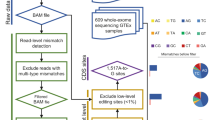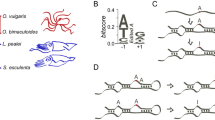Abstract
RNA editing by members of the ADAR (adenosine deaminases acting on RNA) family leads to site-specific conversion of adenosine to inosine (A-to-I) in precursor messenger RNAs. Editing by ADARs is believed to occur in all metazoa, and is essential for mammalian development. Currently, only a limited number of human ADAR substrates are known, whereas indirect evidence suggests a substantial fraction of all pre-mRNAs being affected. Here we describe a computational search for ADAR editing sites in the human transcriptome, using millions of available expressed sequences. We mapped 12,723 A-to-I editing sites in 1,637 different genes, with an estimated accuracy of 95%, raising the number of known editing sites by two orders of magnitude. We experimentally validated our method by verifying the occurrence of editing in 26 novel substrates. A-to-I editing in humans primarily occurs in noncoding regions of the RNA, typically in Alu repeats. Analysis of the large set of editing sites indicates the role of editing in controlling dsRNA stability.
This is a preview of subscription content, access via your institution
Access options
Subscribe to this journal
Receive 12 print issues and online access
$209.00 per year
only $17.42 per issue
Buy this article
- Purchase on Springer Link
- Instant access to full article PDF
Prices may be subject to local taxes which are calculated during checkout




Similar content being viewed by others
References
Polson, A.G., Crain, P.F., Pomerantz, S.C., McCloskey, J.A. & Bass, B.L. The mechanism of adenosine to inosine conversion by the double-stranded RNA unwinding/modifying activity: a high-performance liquid chromatography-mass spectrometry analysis. Biochemistry 30, 11507–11514 (1991).
Tonkin, L.A. et al. RNA editing by ADARs is important for normal behavior in Caenorhabditis elegans. EMBO J. 21, 6025–6035 (2002).
Palladino, M.J., Keegan, L.P., O'Connell, M.A. & Reenan, R.A. A-to-I pre-mRNA editing in Drosophila is primarily involved in adult nervous system function and integrity. Cell 102, 437–449 (2000).
Wang, Q., Khillan, J., Gadue, P. & Nishikura, K. Requirement of the RNA editing deaminase ADAR1 gene for embryonic erythropoiesis. Science 290, 1765–1768 (2000).
Higuchi, M. et al. Point mutation in an AMPA receptor gene rescues lethality in mice deficient in the RNA-editing enzyme ADAR2. Nature 406, 78–81 (2000).
Yang, J.H. et al. Widespread inosine-containing mRNA in lymphocytes regulated by ADAR1 in response to inflammation. Immunology 109, 15–23 (2003).
Patterson, J.B. & Samuel, C.E. Expression and regulation by interferon of a double-stranded-RNA-specific adenosine deaminase from human cells: evidence for two forms of the deaminase. Mol. Cell. Biol. 15, 5376–5388 (1995).
Brusa, R. et al. Early-onset epilepsy and postnatal lethality associated with an editing-deficient GluR-B allele in mice. Science 270, 1677–1680 (1995).
Gurevich, I. et al. Altered editing of serotonin 2C receptor pre-mRNA in the prefrontal cortex of depressed suicide victims. Neuron 34, 349–356 (2002).
Kawahara, Y. et al. Glutamate receptors: RNA editing and death of motor neurons. Nature 427, 801 (2004).
Maas, S., Patt, S., Schrey, M. & Rich, A. Underediting of glutamate receptor GluR-B mRNA in malignant gliomas. Proc. Natl. Acad. Sci. USA 98, 14687–14692 (2001).
Bass, B.L. RNA editing by adenosine deaminases that act on RNA. Annu. Rev. Biochem. 71, 817–846 (2002).
Morse, D.P. & Bass, B.L. Long RNA hairpins that contain inosine are present in Caenorhabditis elegans poly(A)+ RNA. Proc. Natl. Acad. Sci. USA 96, 6048–6053 (1999).
Hoopengardner, B., Bhalla, T., Staber, C. & Reenan, R. Nervous system targets of RNA editing identified by comparative genomics. Science 301, 832–836 (2003).
Paul, M.S. & Bass, B.L. Inosine exists in mRNA at tissue-specific levels and is most abundant in brain mRNA. EMBO J. 17, 1120–1127 (1998).
Kikuno, R., Nagase, T., Waki, M. & Ohara, O. HUGE: a database for human large proteins identified in the Kazusa cDNA sequencing project. Nucleic Acids Res. 30, 166–168 (2002).
Seeburg, P.H. A-to-I editing: new and old sites, functions and speculations. Neuron 35, 17–20 (2002).
Boguski, M.S., Lowe, T.M. & Tolstoshev, C.M. dbEST–database for “expressed sequence tags”. Nat. Genet. 4, 332–333 (1993).
Hillier, L.D. et al. Generation and analysis of 280,000 human expressed sequence tags. Genome Res. 6, 807–828 (1996).
Sorek, R., Ast, G. & Graur, D. Alu-containing exons are alternatively spliced. Genome Res. 12, 1060–1067 (2002).
Morse, D.P., Aruscavage, P.J. & Bass, B.L. RNA hairpins in noncoding regions of human brain and Caenorhabditis elegans mRNA are edited by adenosine deaminases that act on RNA. Proc. Natl. Acad. Sci. USA 99, 7906–7911 (2002).
Maas, S. et al. Structural requirements for RNA editing in glutamate receptor pre-mRNAs by recombinant double-stranded RNA adenosine deaminase. J. Biol. Chem. 271, 12221–12226 (1996).
Polson, A.G. & Bass, B.L. Preferential selection of adenosines for modification by double-stranded RNA adenosine deaminase. EMBO J. 13, 5701–5711 (1994).
Lehmann, K.A. & Bass, B.L. Double-stranded RNA adenosine deaminases ADAR1 and ADAR2 have overlapping specificities. Biochemistry 39, 12875–12884 (2000).
Kim, U., Wang, Y., Sanford, T., Zeng, Y. & Nishikura, K. Molecular cloning of cDNA for double-stranded RNA adenosine deaminase, a candidate enzyme for nuclear RNA editing. Proc. Natl. Acad. Sci. USA 91, 11457–11461 (1994).
Higuchi, M. et al. RNA editing of AMPA receptor subunit GluR-B: a base-paired intron-exon structure determines position and efficiency. Cell 75, 1361–1370 (1993).
Wong, S.K., Sato, S. & Lazinski, D.W. Substrate recognition by ADAR1 and ADAR2. RNA 7, 846–858 (2001).
Lei, M., Liu, Y. & Samuel, C.E. Adenovirus VAI RNA antagonizes the RNA-editing activity of the ADAR adenosine deaminase. Virology 245, 188–196 (1998).
Tonkin, L.A. & Bass, B.L. Mutations in RNAi rescue aberrant chemotaxis of ADAR mutants. Science 302, 1725 (2003).
Ausubel, F.M. et al. Current Protocols in Molecular Biology (John Wiley & Sons, Inc., New York, 1987).
Jiang, R. et al. Genome-wide evaluation of the public SNP databases. Pharmacogenomics 4, 779–789 (2003).
Antonarakis, S.E., Krawczak, M. & Cooper, D.C. in The Genetic Basis of Human Cancer, edn. 2 (eds. Vogelstein, B. & Kinzler, K.W.) 7–41 (McGraw-Hill, New-York, 2002).
Acknowledgements
We thank A. Diber, E. Shuster and S. Zevin for technical help and P. Akiva, A. Amit and R. Sorek for critical reading of the manuscript. The work of E.Y.L. was done in partial fulfillment of the requirements for a PhD degree from the Sackler Faculty of Medicine, Tel Aviv University, Israel. Part of this work was supported by the Austrian Science Foundation grant SFB1706 to M.J.
Author information
Authors and Affiliations
Corresponding author
Ethics declarations
Competing interests
Some authors are past or present employees of Compugen, Ltd.
Supplementary information
Supplementary Fig. 1
Editing in the predicted MGC3329 transcript. (PDF 310 kb)
Rights and permissions
About this article
Cite this article
Levanon, E., Eisenberg, E., Yelin, R. et al. Systematic identification of abundant A-to-I editing sites in the human transcriptome. Nat Biotechnol 22, 1001–1005 (2004). https://doi.org/10.1038/nbt996
Received:
Accepted:
Published:
Issue Date:
DOI: https://doi.org/10.1038/nbt996
This article is cited by
-
New horizons for the role of RNA N6-methyladenosine modification in hepatocellular carcinoma
Acta Pharmacologica Sinica (2024)
-
The epitranscriptome of high-grade gliomas: a promising therapeutic target with implications from the tumor microenvironment to endogenous retroviruses
Journal of Translational Medicine (2023)
-
Precision RNA base editing with engineered and endogenous effectors
Nature Biotechnology (2023)
-
Novel insights into double-stranded RNA-mediated immunopathology
Nature Reviews Immunology (2023)
-
Absolute quantification of single-base m6A methylation in the mammalian transcriptome using GLORI
Nature Biotechnology (2023)



